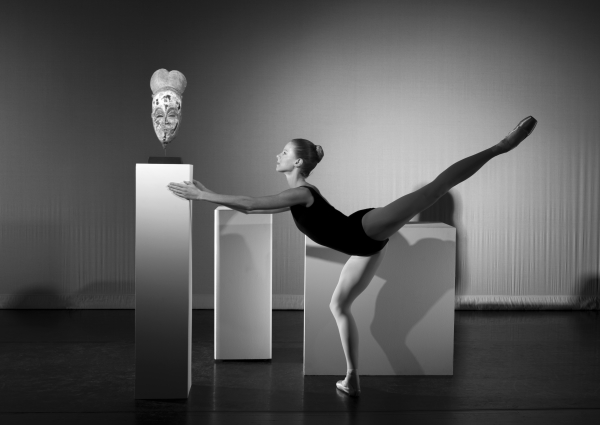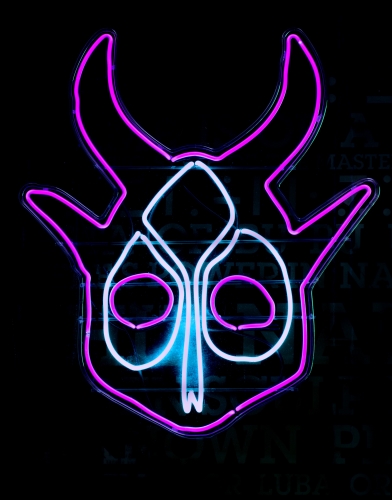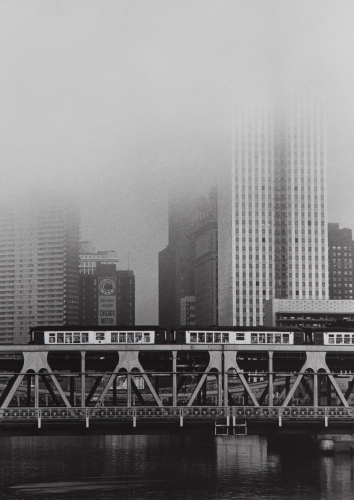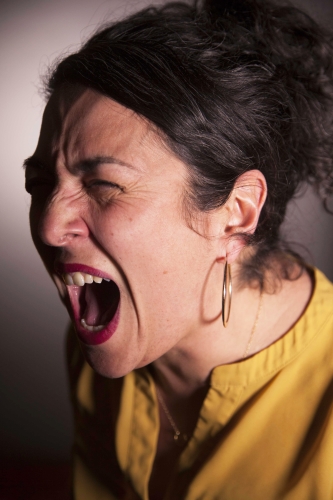
Diverse works include neon African masks, photographs of everyday life in mid-century Chicago and portraits of women screaming
CHICAGO—(ENEWSPF)—August 9, 2018
By: Julie Rodrigues Widholm
Steel sculptures and neon lights by artist and dancer Brendan Fernandes, which are based on fabricated African masks sold to tourists in New York City, anchor one of three exhibitions — “The Living Mask” — that will open this fall at DePaul Art Museum.
The second exhibition, “Someday, Chicago,” examines the work of American-born photographer Yasuhiro Ishimoto through his images of Chicago, where the photographer lived for several years and continued to return to throughout his life.
Also on display will be images of screaming women taken by Chicago photographer Whitney Bradshaw since the Women’s March on Washington in January. “Outcry” asks viewers to contemplate difficult issues related to sexism, power, race, representation and social justice all while demanding that women be heard and believed.
“When I think about the fall exhibition slate, I think about the term ‘outcry’,” said Julie Rodrigues Widholm, director and chief curator of the museum.
“Not only outcry around harassment and sexual assault that Whitney Bradshaw used to help shape her exhibition under that title, but also outcry in that Yasuhiro Ishimoto was interned during World War II due to his Japanese ethnicity. How did that happen and how can we make sure it doesn’t happen again?
“And, outcry around the colonization of Africa, the systemic oppression of certain populations and the misrepresentation of African masks in museums that Brendan Fernandes presents in his exhibition,” said Widholm.
“We hope these exhibitions spark discussions among museum visitors about not only the issues being raised within the artwork, but other areas in society where more justice is needed,” Widholm noted.
The exhibitions open Sept. 6 and run through Dec. 16, 2018, at the museum on DePaul’s Lincoln Park Campus.

Brendan Fernandes: “The Living Mask”
A classically trained ballet dancer, Fernandes started thinking more critically about the profession after he left it.
“Being an artist who works through things like post-colonial history and theories, I started to conflate the two and think about ballet as a Western form of hegemony in a way,” said Fernandes. “Ballet began during the Renaissance and took off in France under Louis XIV. We see ballet on stage and it’s beautiful and romanticized, but I want to create a new dialogue, a new kind of understanding to this form as well.”
Born in Kenya to descendants from Goa — a former Portuguese colony in India — Fernandes and his family left Kenya for Toronto in 1989 due to political unrest in the country.
That background plays strongly into Fernandes’ work as he continues to explore his African heritage through art.
“In my work, I’m asking questions about identity, authorship and authority. But at the end of the day, I’m asking these questions about who I am. I’m a Canadian and a Kenyan who is of Indian heritage and lives in the U.S., and I’m sort of questioning my sense of cultural authenticity. Many of these objects in my exhibition are also African. What’s their cultural authenticity?” asked Fernandes.
Among the pieces Fernandes provided for the exhibition are several black-and-white photographs from his “As One” series taken in 2017. The images show white ballet dancers in poses alongside African masks positioned on stands. The ballet poses are specific and intentional and show deference to the masks, Fernandes explained.
“The poses towards the masks are kind of questioning that post-colonial history,” he said. “This westernized, stylized and civilized body is genuflecting towards the masks and at the same time becomes the body of the mask.”
Three African masks made with neon lights also are displayed in the exhibition. Fabricated African masks sold as tourist souvenirs on Canal Street in New York City, but based on objects in the Metropolitan Museum of Art Collection inspired Fernandes to create these pieces.
Nine African objects from DePaul’s collection, including masks from the Republic of Congo, Cameroon and Nigeria, round out the exhibition.
“The exhibition addresses race and power in museums,” said Widholm, curator of this exhibition. “We landed on the title ‘The Living Mask’ because we felt the masks were really objectified in the museums, and they aren’t thought of as having a life to them. Living refers to the body that would use them. We are trying to reanimate them. They belonged to a certain kind of people who used them in a certain type of way with their bodies. They aren’t dead objects, they are living objects,” she said.
Fernandes and Widholm hope the exhibition starts a conversation about how to talk about African objects that are collected by in Western museums.
“African masks used to be worn while dancing,” said Fernandes. “We take away the dances and the human element when they are at museums. They’re relegated to being an exotic commodity, we have changed the way they function. So I want to bring back the history of their lived experience. How, who and why were the dances performed?
“I don’t think the answer is to send these objects back to where they came from, but we do need to acknowledge the history and question the narrative that exists. It’s more about a conversation, and that’s what I’m trying to do with my pieces. Why ballet and African masks? Now, there’s a reason to bring it up and have a conversation about it,” Fernandes said.

Yasuhiro Ishimoto: “Someday, Chicago”
Born in the United States and raised in Japan, Ishimoto returned to the U.S. in his late teens. Only a few years later he became one of more than 115,000 Americans with Japanese ancestry forced into internment camps during World War II. It was in the internment camp where he first developed an interest in photography, showing a formal rigor and keen eye for composition, according to the exhibition’s guest curators, Jasmine Alinder and John Tain. Alinder is an associate professor of history at the University of Wisconsin-Milwaukee, and Tain is head of research at the Art Asia Archive in Hong Kong.
Following his release at the end of the war, the U.S. government sent Ishimoto to Chicago, where he developed a lifelong love of the city and continued his work with photography.
Living in the city from 1945-52 and then again from 1958-61, Ishimoto developed his unique modernist vision. He studied at the Institute of Design at the Illinois Institute of Technology and took photographs on the city’s streets, creating images of iconic Chicago landmarks like the Loop and the ‘L’ train, and also of everyday life — people walking to work or a car driving by. He went into segregated neighborhoods to take photographs of daily life, as well as public spaces where racial and class mixing more commonly occurred.
“As part of a minority ethnic group that had been legally segregated and declared a threat to national security, Ishimoto knew well how it felt to be excluded, ostracized and even demonized because of one’s racial identity,” said Widholm.
“Ishimoto’s work focused on documenting elements of everyday life — such as African American children dressing up for Halloween or families in Lincoln Park lounging on the beach — in order to create an empathetic, humanist lens for his subjects. His black-and-white photographs of communities in Chicago and elsewhere show us how we are, ultimately, more the same than different,” Widholm said.
A well-known artist internationally, Ishimoto is considered a master of black-and-white photography. After returning to Japan in 1961, he revisited his earlier interest in architectural photography and later turned to Cibachrome photography, which was an innovative color process he utilized to create abstract images. Though Ishimoto visited Chicago numerous times, he lived primarily in Japan until his death in 2012.
The DePaul Art Museum exhibition “Yasuhiro Ishimoto: Someday, Chicago” features more than 50 works that include both black-and-white photographs from his work in the 1940s, 1950s and 1960s in Chicago and his Cibachrome photographs from the early 1980s.
“My favorite pieces in the show are the photographs he made in Chicago from the late 1940s through the early 1960s,” said guest curator Alinder. “Ishimoto was able to integrate the concern of a social documentarian with an attention to visual aesthetics that he honed while he was a student at Chicago’s Institute of Design.”
“Although Ishimoto spent a great deal of his life in Japan, he thought of Chicago as his home city, and I hope this exhibition brings his work and artistic legacy to a new generation of Chicagoans,” said Alinder.
The exhibition is part of Art Design Chicago, an exploration of Chicago’s art and design legacy, an initiative of the Terra Foundation for American Art with presenting partner The Richard H. Driehaus Foundation.

Whitney Bradshaw: “Outcry”
Defined as a loud, piercing cry or cries expressing excitement, great emotion or pain, a scream can be a powerful tool for the overlooked to express public anger or disapproval. In her exhibition for DePaul Art Museum, Bradshaw’s “Outcry” features 108 portraits of women screaming that she’s photographed since Jan. 20, 2018, the day of the Women’s March on Washington.
Each photograph is a document of much more involved events created by Bradshaw in her home studio where she invites groups of women to scream in response to the silencing they’ve experienced. “Outcry” challenges stereotypes around women and femininity, while celebrating their resilience and insisting on a reconsideration of beauty and power, she said.
Bradshaw developed the idea of exploring the silence surrounding sexual violence and harassment while working with the local nonprofit organization Rape Victim Advocates when she was in her 20s. With the recent rise of the #MeToo movement, Bradshaw felt the time was right for the project since she had identified a way to explore these difficult issues that was positive, therapeutic, empowering and fun for the women involved, she said.
“I wanted to engage in a project that brought women together to support one another in an exercise that would allow each of us to, bravely, practice speaking out and being heard, all with a supportive group around us,” said Bradshaw. “My hope is that this project empowers the women involved, while expanding our community, fostering empathy and encouraging support by all who come into contact with it.”
In addition to the images on display, Bradshaw will hold two scream sessions at the museum Sept. 21 and Nov. 10. Just as in her home studio, Bradshaw will work with small groups of 10-20 women who don’t know one another to create a safe space in which each can practice expressing themselves unencumbered. She will make individual portraits of each woman as they take turns screaming in front of the camera while being encouraged by the others in the group. These portraits will be added to the installation over the duration of the exhibition along with any new portraits she makes during her continuous home studio sessions.
“The ambiguity of the expressions are one of the things that interests me about the project because each person is screaming for their own reason, one that most of the time I am unaware of as it is their personal experience,” said Bradshaw. “The range of expressions makes the project richer as it allows the viewer to imagine what they might be feeling, and hopefully it encourages empathy in that moment of engagement.”
Neon art piece: “Tourist/Refugee”
One additional work of art will hang in the West-facing window closest to the Fullerton ‘L’ stop between the summer and fall exhibitions in August and then again in December between the fall and winter exhibitions. Called “Tourist/Refugee,” the piece is a blinking neon light that flashes the word tourist followed by the word refugee.
Chicago-based artists Adam Brooks and Mathew Wilson, who call themselves “Industry of the Ordinary,” designed the piece in order to address the implications of foreign policy on the movement of people across borders and the humanitarian responsibility of providing aid for refugees.
On Oct. 8, Columbus Day — or Indigenous People’s Day — Industry of the Ordinary will hold a silent vigil at 5:30 p.m. at Saint Vincent de Paul Church in remembrance of the many thousands of displaced people who have recently tried, and often failed, to find safe harbor. Titled “Genuflect,” the procession will then head east to Lake Michigan.
DePaul Art Museum is located at 935 W. Fullerton Ave. Hours are 11 a.m. to 7 p.m. Wednesday and Thursday; 11 a.m. to 5 p.m. Friday and 11 a.m. to 5 p.m. Saturday and Sunday. The museum is closed Monday and Tuesday. Admission is free. Additional information at http://museums.depaul.edu or 773-325-7506.
Source: www.depaul.edu








